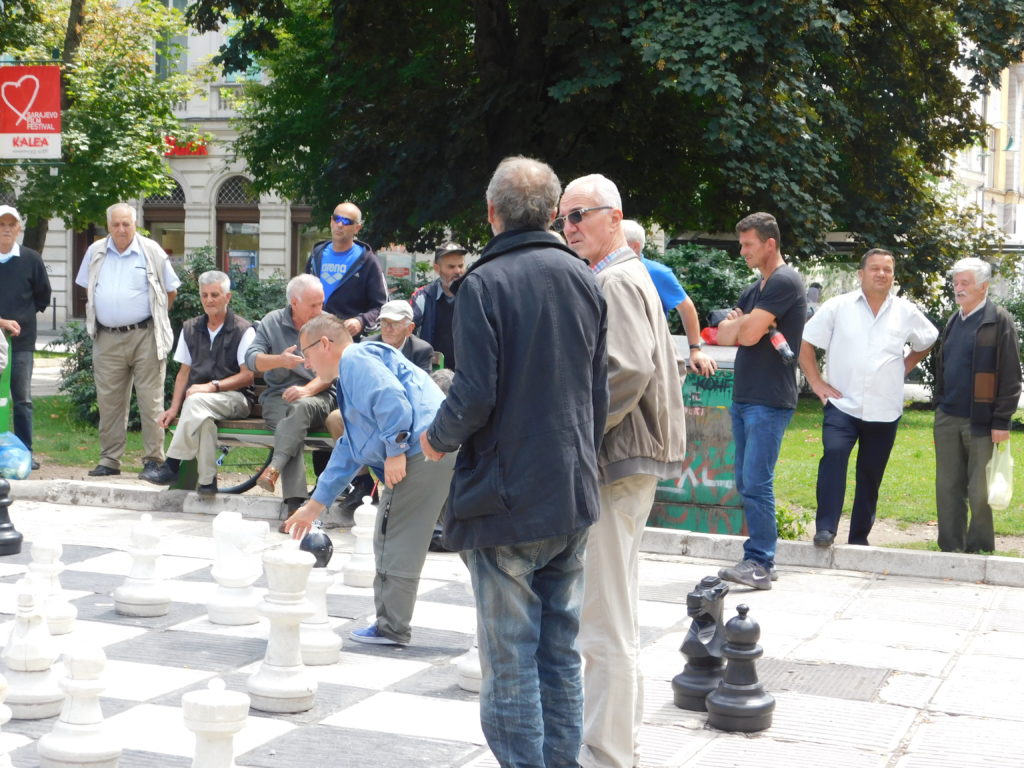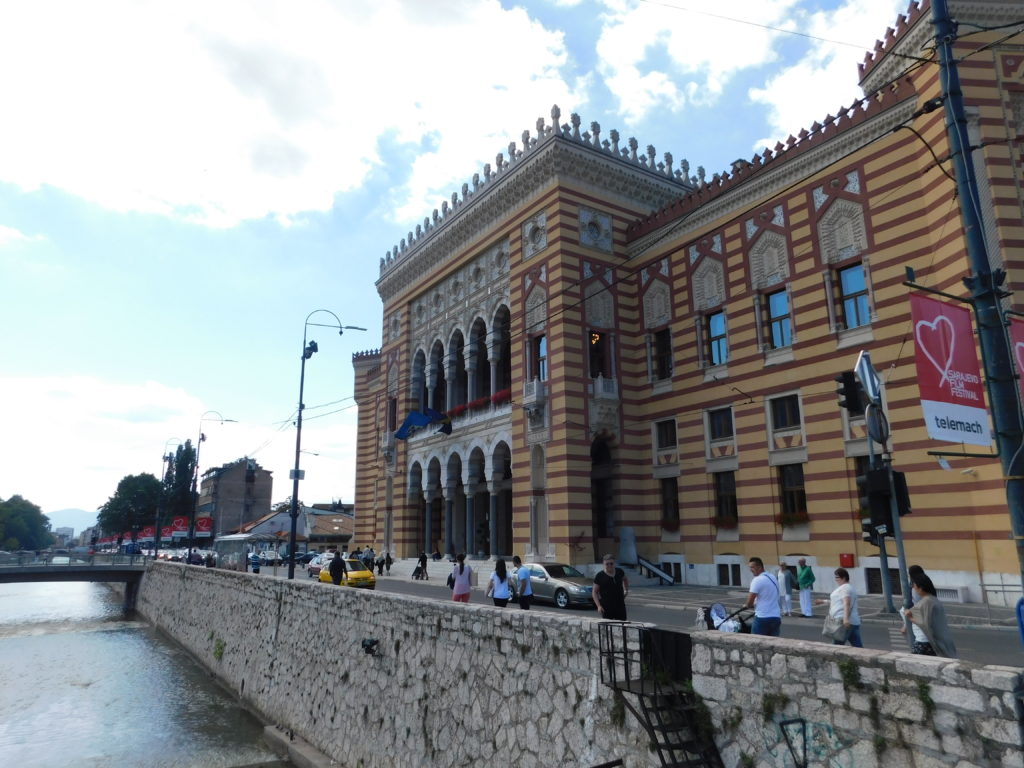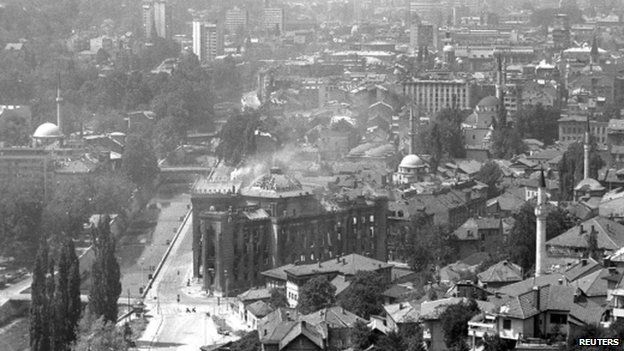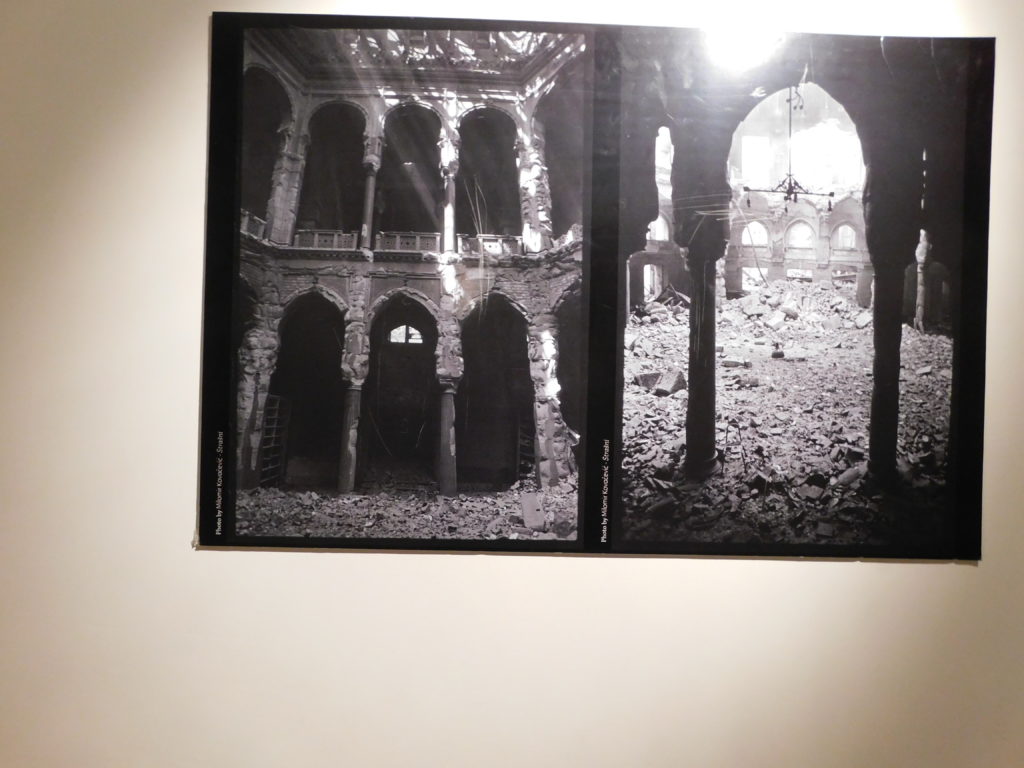Now, back to the Jews of Sarajevo. The Austro-Hungarian Empire collapsed at the end of World War I and the Kingdom of Serbs, Croats and Slovenes formed in 1918. In a 1921 census, Sarajevo had 70,000 residents and 10,000 claimed Ladino as their native tongue. Approximately the same number of Jews lived in Sarajevo in 1940 and the total Jewish population of B&H was about 14,000.
Following the Nazi invasion of the Kingdom of Yugoslavia, B&H came under the rule of the Nazi puppet Independent State of Croatia headed by the fiercely nationalistic, fervently Catholic fascist Ustaše. (Ustaše or Ustaša is a term that might reappear together with the equally derogatory Chetnik in some discussions of the nineties wars.) The Ustaše immediately began persecuting and slaughtering non-Catholics throughout the Balkans particularly Serbs (500,000 killed by the end of World War II), Roma (40,000), and Jews (32,000).
About half the Jews in B&H survived the war. Some did so by joining Tito’s Partisans, some fled to the Italian controlled Dalmatian coast, and others survived because of their distinctly non-Ashkenazic names and appearance such as appears in the photo below:
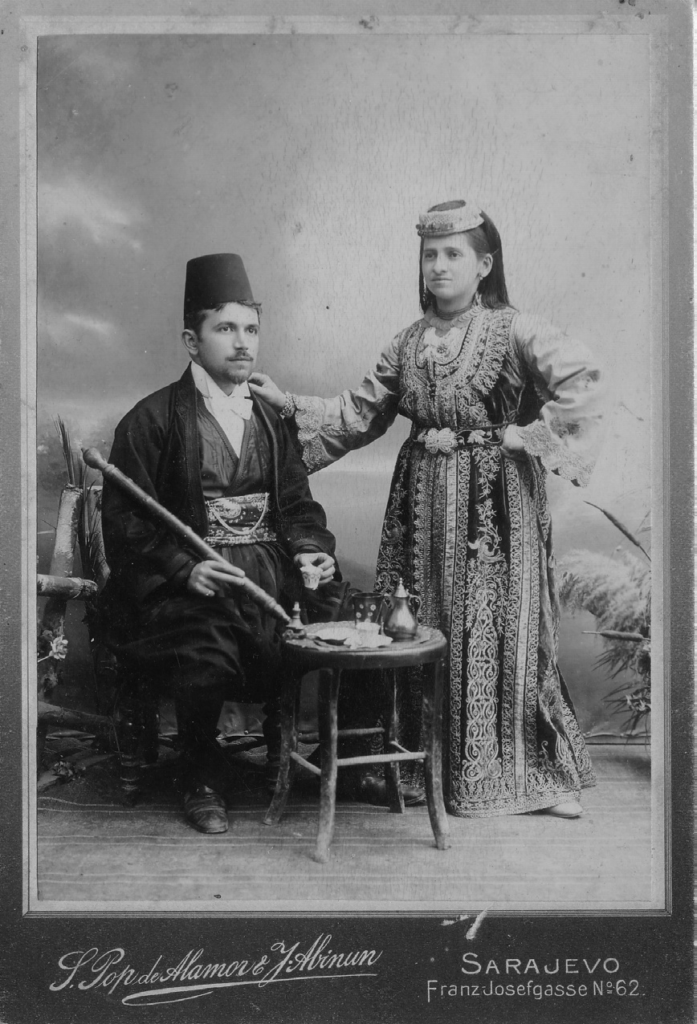
It’s finally time to return to the tour and those bureks.
The last stop we made was at a shop where our guides Dino and Damir treated us to platefuls of bureks. Technically, I’m not sure everything we ate were bureks. Reading about the dish has led me to believe that the term burek, while often used as a sort of simplified shorthand for tourists to apply to any of these stuffed pita rolls, is rightly applied only to the meat stuffed pastry. We were given platefuls of the rolled pastries stuffed not only with meat but with cheese (sirnica), potatoes (krompiraca), and spinach (pita od spanaka). Everyone seemed to find one or more of the varieties to their liking and we happily stuffed our faces leaving four clean trays.
An afternoon on our own.
Now that we’d been left to our own devi-i-i-ices, I was determined not to let the day fall away with nothing to show. I had a few spots in particular I wanted to see that were within easy walking distance and I managed to drag along my regular companions.
Knowing that the schedule for our second day in Sarajevo would be almost exclusively devoted to some of the events in the Bosnian War, it seemed only natural that I should spend at least part of the day seeking out memorials to other wars fought in the territory of B&H – notably, the Second World War. One of these, an Eternal Flame or (Vječna vatra in Bosnian), was just a short walk from where we’d eaten our lunch of bureks.
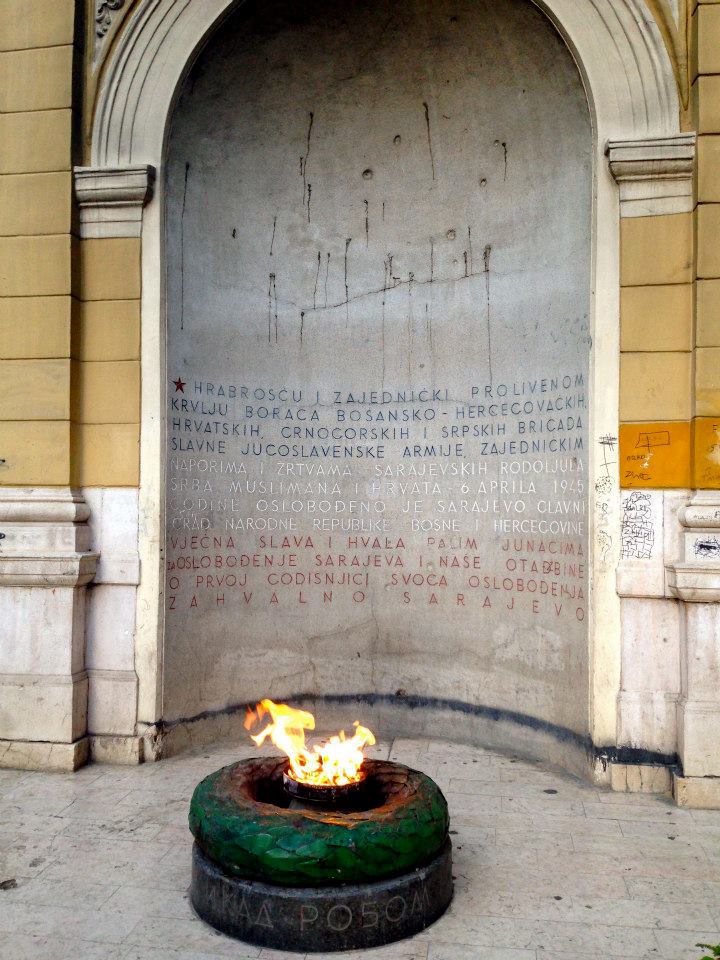
The memorial commemorates the sacrifices of civilian and military victims of World War II in both Sarajevo and all of B&H. It was originally dedicated on 5 April 1946 which was the first anniversary of the country’s liberation from Nazi Germany and its puppet fascist state – the so-called Independent State of Croatia. Here’s a translation of the inscription from liquisearch.com:.
With Courage and the Jointly Spilled,
Blood of the Fighters of the Bosnian-Herzegovinian,Croatian, Montenegrin, and Serbian Brigadesof the Glorious Yugoslav National Army; with the Joint Efforts and Sacrifices of Sarajevan PatriotsSerbs, Muslims and Croats on the 6th of April 1945
Sarajevo, the Capital City of the People’s Republicof Bosnia and Herzegovina was liberated.
Eternal Glory and Gratitude to the Fallen Heroes
of the liberation of Sarajevo and our Homeland,
On the First Anniversary of its Liberation – a Grateful Sarajevo.
As you look at the photo, look above the inscription and you can see the physical reminders that in Sarajevo you’re also never far from traces of the Bosnian War.
A short walk from the Eternal Flame, and across from the Cathedral Church of the Nativity, is Trg Oslobođenja – Alija Izetbegović or, as it’s colloquially known, Liberation Square. You should recognize the name of the first President of B&H and reasonably conclude that it celebrates the state’s independence. Two notable elements should prompt any visitor to Sarajevo to stop at Liberation Square. The first is the bronze sculpture called “Multicultural Man Builds the World.” It’s one of five such statues around the world. The first was unveiled in Toronto in 1985 and the Sarajevo version was completed in 1997 – the second to be unveiled. The doves on the statue represent peace, of course, and the man is trying to bring the world together in peace. (Look closely at the photo, however, and you can spot at least one very real slightly larger Columbidae family relative.)
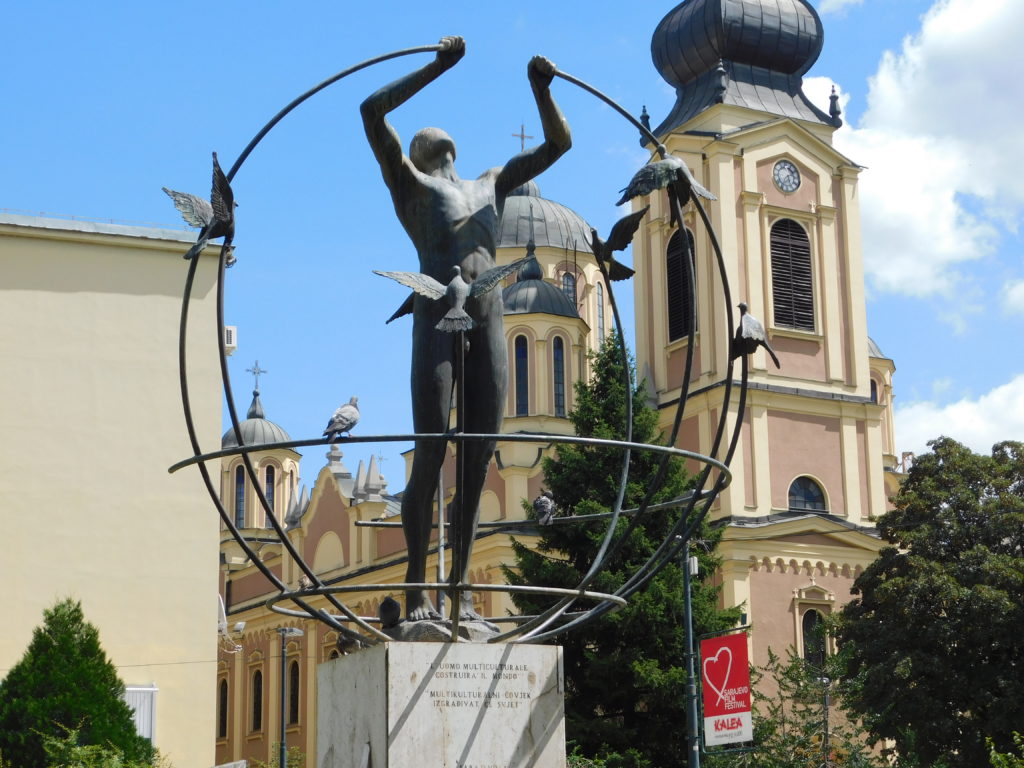
The sculptor, Francesco Perilli, stated that his intent is to show “a man trying to connect two ends.” According to the Spotted by Locals website, the phrase “trying to connect two ends” in Bosnian “refers to someone trying to get through the month, surviving from the end of one month to the end of the next month.” Perhaps it’s appropriate then, that while the sculptor originally planned to place one copy on each continent, the project sadly stalled due to lack of funds.
The other reason to visit the square is to watch the chess players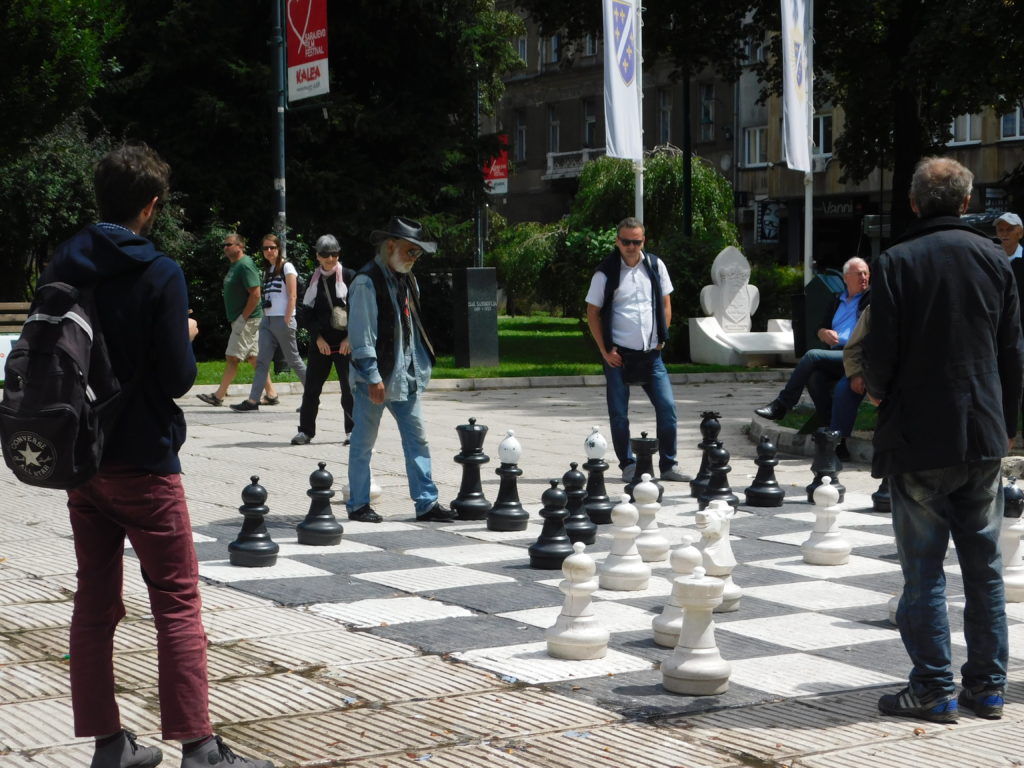 and the kibitzers who undoubtedly take the game going on in front of them as seriously as the players do.
and the kibitzers who undoubtedly take the game going on in front of them as seriously as the players do.
From the square, we walked back though the marketplace and, after a false start or two, found our way to the (small by American standards) Brusa Bezistan Museum that chronologically traces the arc of human habitation in and around Sarajevo. The permanent exhibition displays archaeological material and is divided into three sections: prehistory, antiquity, and the Middle Ages. During our visit we also saw displays from both the Ottoman and Austro-Hungarian periods. The lone photo I took was of this glass enclosed model of the Baščaršija in its glory.
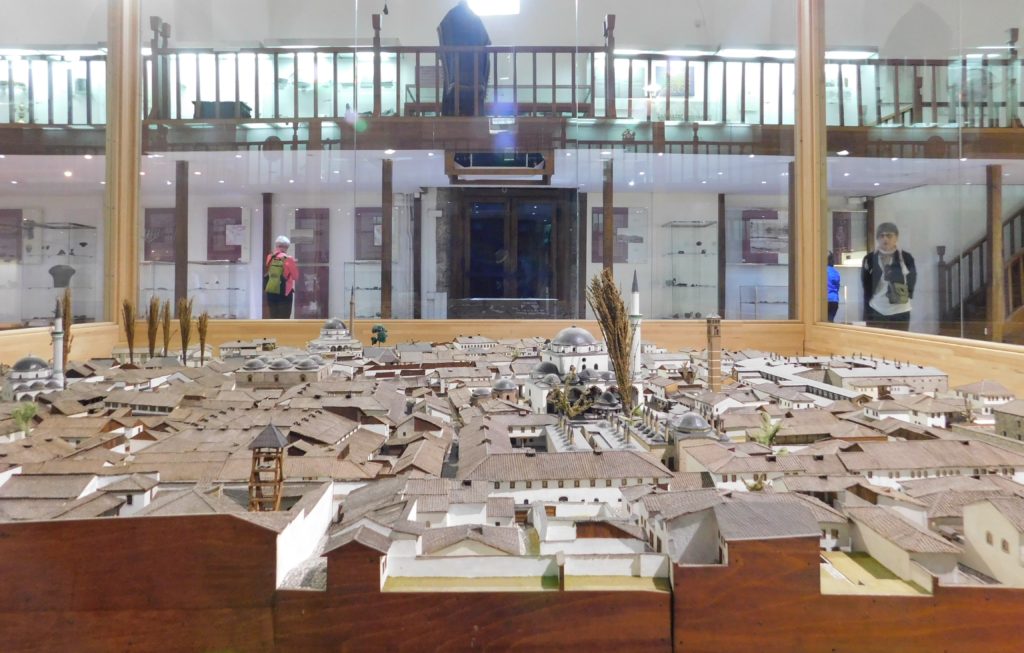
(That’s Pat facing the camera, Geanie in the red on the left and Judy whose blue jacket is peeking around the pole behind Pat.)
From there, we crossed to the south side of the Miljacka River and climbed the hill to the Sarajevska pivara or Sarajevo Brewery. I’d already had plenty of its signature brew, Sarajevsko pivo and found it refreshing enough even if the finish was a bit too bitter for my preferences.
The building itself is something of a landmark in the city. It opened in 1864 making it, by some accounts, the oldest industrial plant in B&H and architecturally it’s a mix of Turkish and classical European styles. Despite being nearly destroyed in the nineties wars, it has brewed continuously since its opening. Its output during the Bosnian War was a symbolic three percent of capacity. However, for a time it served a much more important purpose as the only source of drinking water in the besieged city.
I didn’t take a photo so I’ve downloaded this one from a Google search:.
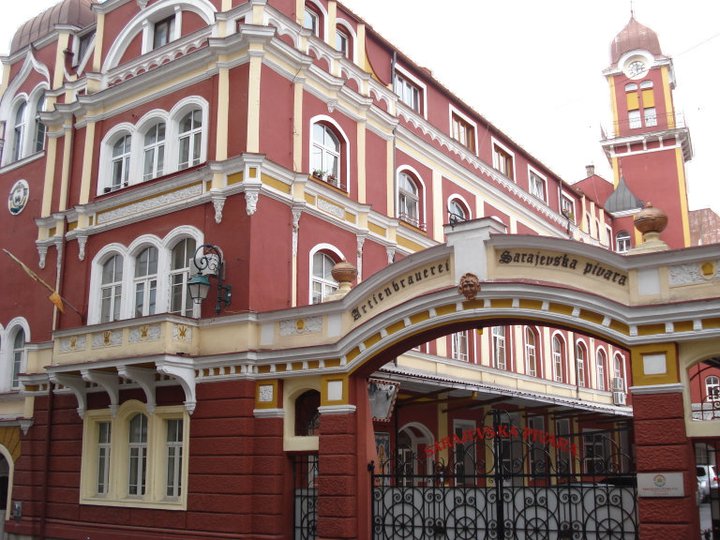
We enjoyed a beer in the pub in the brewery as a nice break on a warm day.
Working our way back down the hill, we closed the circle of the day by visiting the City Hall. Recall that the City Hall was built by the Austrians in a pseudo-Moorish style and opened in 1894. It served in that capacity until 1949 when it was given to the National and University Library of Bosnia and Herzegovina. As a reminder, today the building looks like this:.
Though taken from a different angle, this picture from the BBC shows what the building looked like after coming under incessant shelling by Serbian forces on 25 August 1992:.
A plaque at the entrance quantifies the destruction of the contents but fails to communicate the resulting cultural losses.
Inside, the restored city hall recaptures the grandeur
while the underground museum reminds visitors of the devastation.
In this instance, I’ll allow the photos to speak for themselves and return in my next entry with more experiences in Sarajevo.
